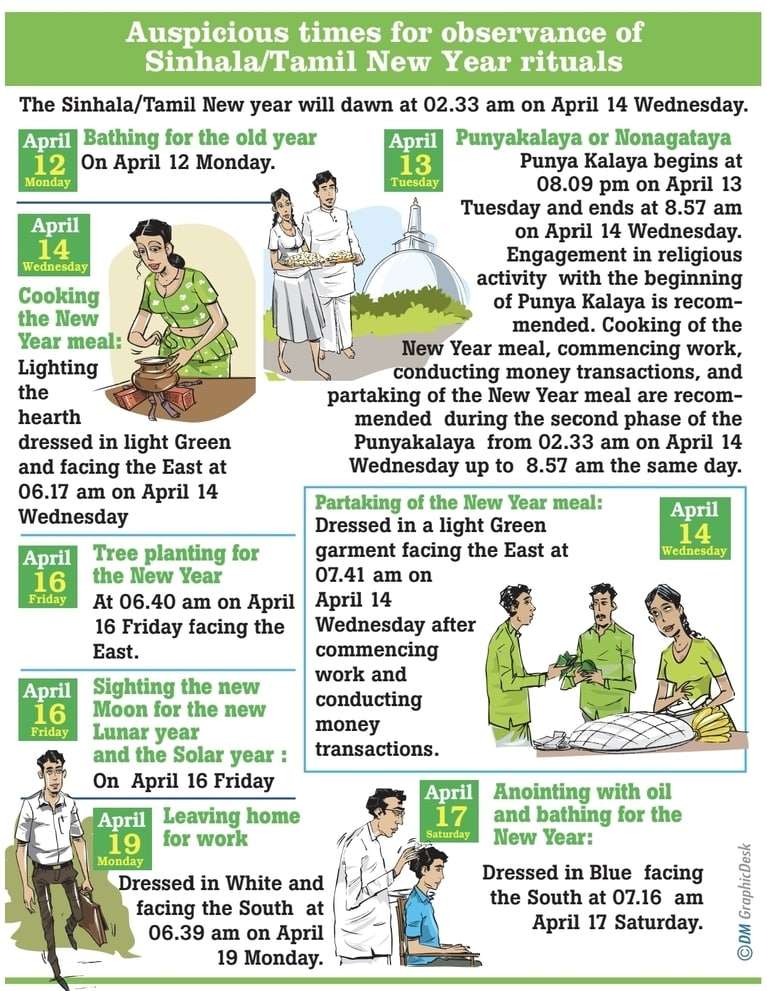
Apr 09 2021.
views 1150The transition of the Sun from Aries to Pisces, also known as the Sinhala and Tamil New Year is a much-awaited season in the Sri Lankan calendar. During the colonial period, the Sinhala and Hindu New Year was enacted as a holiday in 1886 as per the National Holidays Act. Subsequently, in 1984, during President J. R. Jayawardena’s tenure, it was termed as the Sinhala and Tamil New Year.
Back in the day, the blooming of Erabadu and Ehela flowers and cooing of the Koha (Asian koel) were believed to be signs from nature signifying the dawn of the New Year. In rural Sri Lanka, preparations for the New Year began days or rather months ahead. Harvest from Yala and Maha seasons were offered to a temple, also known as Aluth Sahal Mangallaya (New Rice Festival) and thereafter kitchens eventually got busier by the day. Prior to preparing meals the hearth and in fact, the house is given a facelift. Traditional hearths are usually given a fresh look by applying clay or cow dung. Womenfolk would then take matters into their hands and start preparing everything from spices to the main meals at their respective households.
The New Year is a time for the entire family and neighbourhood to get together and celebrate fellowship. As days get closer, the youth get busy, organising Avurudu festivals and engaging in traditional games. The exchange of sweets and kitchen utensils were a part of this fellowship.
However, over time, this grand celebration is now confined to the rituals which people still believe are compulsory to follow. With rapid urbanisation, many have moved away from getting the feel of this celebration of the past.
We, therefore, asked a few people about how they remember Avurudu being celebrated some 30-40 years ago. Here’s what they had to say :
Samanthi Colonne
In our home, Sinhala and Tamil New Year also coincided with a birthday. So it was a double celebration. We never followed auspicious times. On the morning of the New Year, it would be the traditional breakfast with kiribath etc... After that our parents would take us and visit our maternal grandparents and paternal grandmother. We’d offer beetle and worship them and any other elders who were present. Then gifts were exchanged, with lots of hugs and kisses. Invariably lunch would be at one of those homes. I remember that getting home in the evening, I’d be dosing off in the backseat of the car as I’d be so tired from playing with my cousins. Up to date in our household, we don’t follow auspicious times.
Harshani Fernando
This is 30 years ago. I lived in a flat in Colombo. There was diversity. The neighbourhood was very united. With the limited space we had, the youth as well as adults engaged in Avurudu games. We were Catholic so we got lots of plates of avurudu kevili which we ate for days and even shared. After some years lives got more complicated and busy for everyone. Some shifted houses and we really miss that feeling now. Visiting grandparents (they were in Colombo and Buddhist) to greet and receive their blessings was part of the day.
New Year season was a very special period for all the kids. The atmosphere, filled with the fragrance of flowers and fruits, made all children happy and free. Children played around the trees, gardens and in the neighbourhood. There were no parapet walls or fences around the houses. Everyone played together and ate wherever they wanted. During this era, most mothers didn’t work as their hands were full, taking care of children. Not only theirs but also the visitors’ or friends’, children.
Every house had a Litha in its kitchen wall and followed all rituals as given in the Litha. The auspicious timings of the Sinhala New were decided by the Priests who had studied astrology, taking into account the planetary conditions and calculating the most auspicious time and publish it as “Litha.” The daily routine had to begin with the auspicious times.
With the dawning of the New Year, the very first thing done by the eldest female of the house is to light the fire facing the direction given in the Litha and boiling of milk. Making of milk rice follows. The table is laid with all kinds of sweets, kiribath and plantains. Everyone dresses in new clothes made with the colour specified in the Litha.
Feeding the younger generation by the eldest of the clan is a must and after having a mouthful of milk rice from the grandparents, the children and their siblings follow the same ritual with their families. Then comes the “Ganu-Denu”. More than anything this is the moment of fun, visiting neighbours is a must with a full plate of sweetmeats and fruits. Soon after harvest of the paddy fields prior to New Year, the older generation divided a portion of it to the temple and a portion to be given to the dear and near ones.
Even after each meal, they leave some rice for the birds and some food for other animals. Games during this period were real fun. Pancha, cards and carrom as indoor games and gudu, cricket, football and netball as outdoor games.
Leaving the Grandparents was the last and the most painful event. Packed bags with fruits and goodies, we leave the old parents at home. But they were never alone. At least one or two families lived with them. As the family is large, this was possible. hen you look back, the economy has improved. The houses are large with expensive furniture. But, each person has their secluded world. They seldom talk, play or sing together like in the olden days.

0 Comments